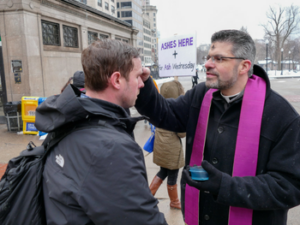
I’m off to help distribute ashes at Mass later today. I’ve done this a few times in my life, and it’s always a humbling experience. Yes, the ashes remind us of our mortality and dependence on God, but that’s not mostly why I feel humbled. It’s humbling for me because I get to see so many different people, with different stories and backgrounds, all coming to get smudged with dirt for different reasons.
Our participation in the Ash Wednesday ritual gives God the chance to quietly draw us closer to him.
In their faces I see glimpses of piety and holiness, fear and trepidation, giggly discomfort in some of the adolescents and stoic disinterest in some of the teens. Some people aren’t sure if they’re supposed to say anything in response (you’re not), and some don’t quite know if they’re allowed to wipe off any ash that falls on their nose (you can). But in every case, they come, young and old, those barely able to walk and babies in mothers’ arms. And God, in whatever way is needed, touches each of them through this simple act of penance. We may not understand the ritual, we might do it just out of habit. But it’s our doing of the ritual, our turning back to God, even for just a moment, that gives God the perfect opportunity to quietly, even unknowingly, draw us ever closer to him.
“Remember, man, you are dust and to dust you will return” (Gn 3:19). This reminder is given to those who are signed with ashes at the beginning of the Lenten season. This ancient action of wearing ashes has traditionally signified lamentation and repentance (see 2 Sam 13:19, Esth 4:1, Job 42:6, 1 Macc 3:47, 4:39, Lam 2:10, Mt 11:21). Still today, this symbol speaks dramatically of both the morbid reality of being human and the joyful promise made to all God’s own.
Why do we wear ashes?
Ashes symbolize sorrow and penitence. The early church ritualized this for those who had committed a serious or “capital” sin. These “penitents” would wear a penitential garment and have ashes sprinkled on them. Then they would be excluded from celebrating the Eucharist until the Easter Vigil. (Note that a person could be a penitent only once in a lifetime.) Although the order of penitents had declined, by 1091 all the faithful were encouraged to take on the practice of wearing ashes at the beginning of lent. Today we continue this practice as an expression of “our human condition as affected by sin” (Ceremonial of Bishops, 253). We mourn for “our sin and ignorance” (Responsory for Ash Wednesday) that has kept us from keeping faithful to our baptismal promises. We are marked with ashes as a sign of our commitment to “turn away from sin and be faithful to the gospel” (Mk 1:15).
We are marked with ashes as a sign of our commitment to “turn away from sin and be faithful to the gospel” (Mk 1:15).
Where do the ashes come from?
The rubrics for Ash Wednesday say that “the ashes used today come from the branches blessed the preceding year for Passion Sunday.” Though there is no special rite for burning palm branches, many communities have made a tradition of preparing their own ashes during the weeks before Lent.
How long do I have to wear these ashes?
There is no rubric that states that ashes need to be worn outside of the Ash Wednesday liturgy, though you’ll see many smudged foreheads at work and on the streets on that day. The wearing of ashes is meant to be a sign of our inward conversion, and, as the Gospel of the day warns, not a way to gain applause. However, this could be a way to quietly evangelize our places of work and to find support from unknown fellow Catholics.
Is it a sin to not get ashes on Ash Wednesday?
Some people believe that it is a sin to miss receiving ashes on this day. Some even believe that one would not go to heaven if he or she were not marked with blessed ashes. Neither is true. (Ash Wednesday is not even a holy day of obligation!) This of course does not mean that we shouldn’t participate in this liturgy, nor does it mean that the symbol isn’t important. Wearing ashes must reflect our desire to act from our baptismal promises. Saying “we believe” requires us to live dead to sin. Wearing ashes demands that we live alive for Christ.










“However, this could be a way to quietly evangelize our places of work and to find support from unknown fellow Catholic” (4th paragraph above); this statement jumped out at me and I read it at least 6 times! An excellent thought! I will remember it and use it in my RCIA and Adult Confirmation classes.